1、Overview of Navigation Routes and Anchorages from the Main Channel of Qingdao Port to Chaolian Dao Waters
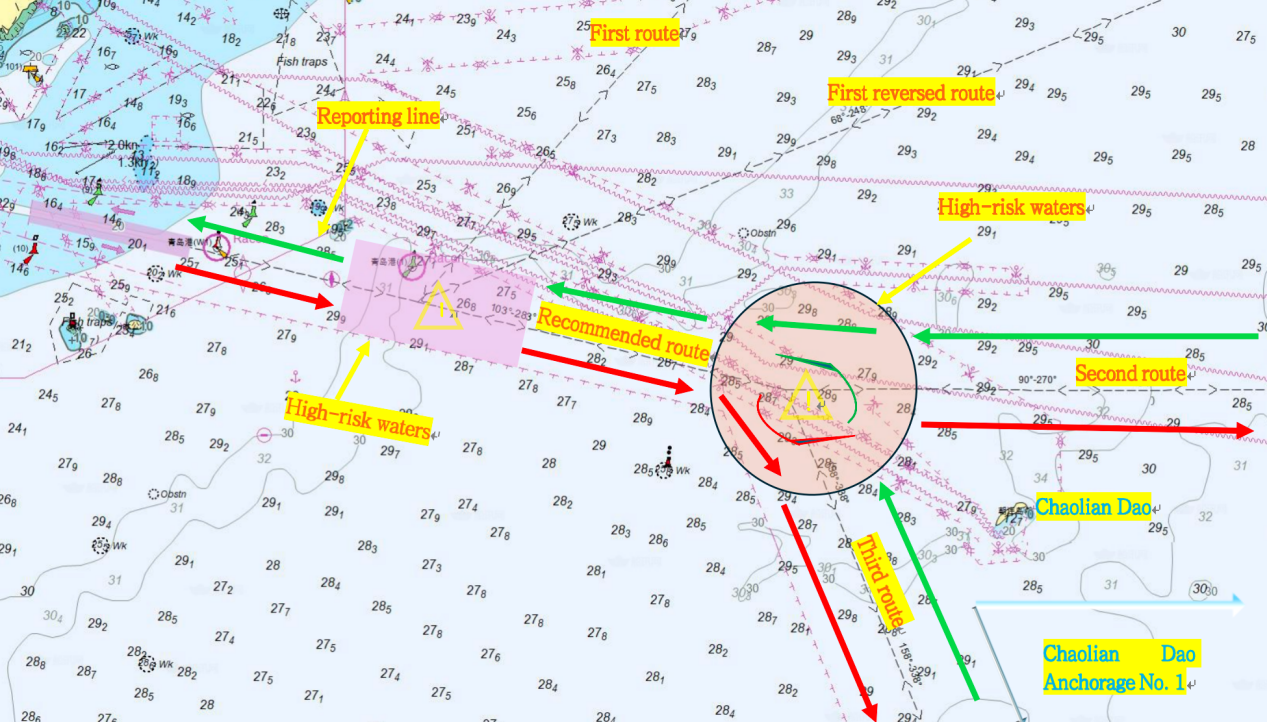
The main channel waters of Qingdao Port east of the line joining Dagong Dao and Xiaogong Dao encompass recommended inbound/outbound routes (283°/103°), the First Route (222°/042°),the First Reserved Route (248°/068°), the Second Route (270°/090°), and the Third Route (338°/158°). Among these, the converging and junction areas of the First Route and the First Reserved Route (waters near the buoy Qingdaogang(1)) and the junction area of the Second Route and the Third Route (5 NM northwest of Chaolian Dao) serve as the primary convergence zones for vessel traffic (including fishing boats) and are associated with a high risk of collision,where all vessels should navigate with extra caution.
The Chaolian Dao Anchorage No.1 is applicable to all vessels except oil tankers、liquefied gas carriers and chemical tankers. Within the anchorage area, 30 anchor berths are designated, centered on points A1 to A30 with a radius of 957.5 meters each.The anchorage water depth ranges from 28.2 to 36.2 meters.
2、Recommended Navigation Method for the Qingdao Port Main Channel to Chaolian Dao Waters:
Vessels shall keep to the starboard side of the channel as far as practicable. Inbound traffic flow is marked with green arrows, while outbound traffic flow is indicated by red arrows. This is designed to separate opposing streams of traffic, minimize potential head-on and crossing situations between vessels, and mitigate risk of collision.
2.1 Waters along the line joining Dagong Dao and Xiaogong Dao

Very large vessels (a vessel that her actual maximum draft is 15 meters or above) shall utilize the deep-water channel of Qingdao Port's main channel; pilots will embark/disembark abeam of Xiaogong Dao.
Other vessels (excluding very large vessels) shall comply with the provisions of the “The Ships’ Routeing System in the Waters of Qingdao” and navigate within the designated traffic lanes.
2.2 Waters from the line joining Dagong Dao and Xiaogong Dao to Chaolian Dao
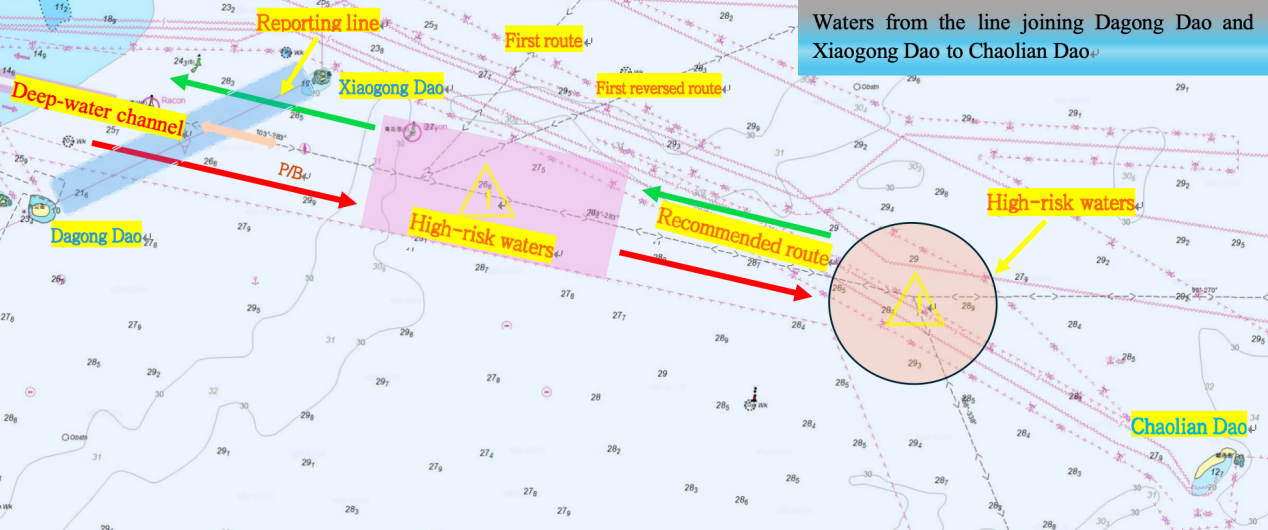
Vessels shall navigate with particular alertness and caution in the following two high-risk waters for vessel convergence and collisions.
2.2.1The Intersection Waters of the First Reserved Route and the First Route
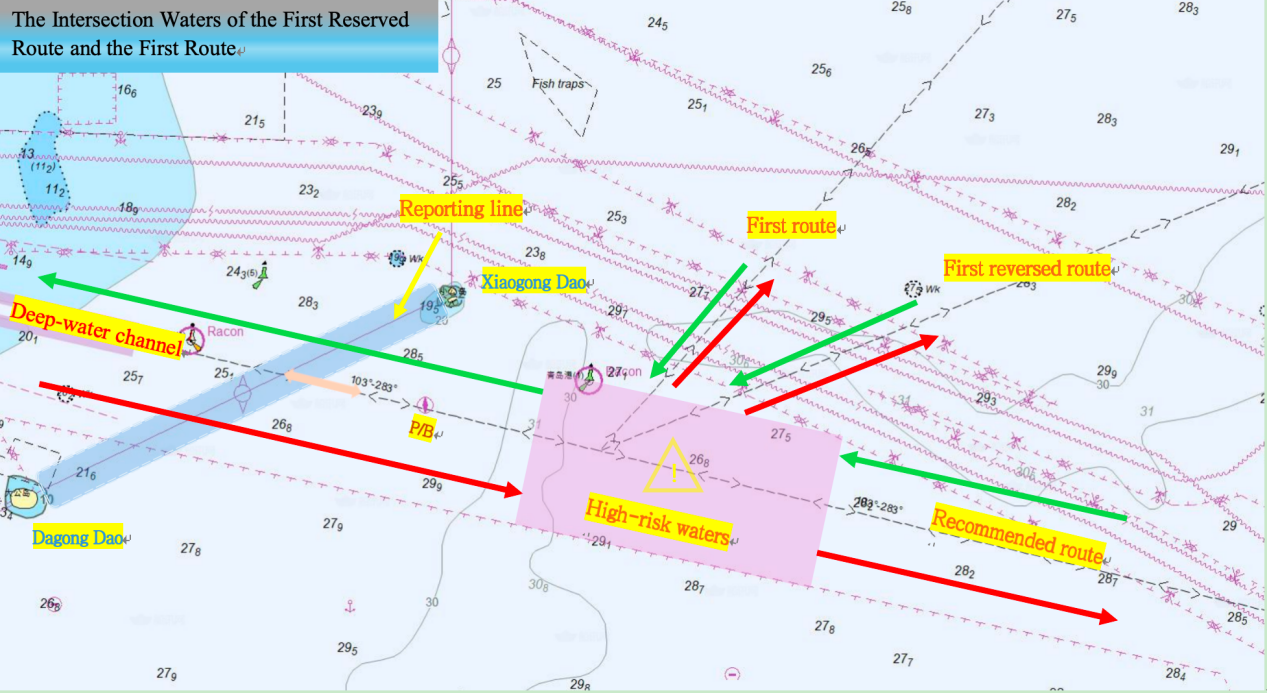
For Vessels Joining the Main Channel:
Inbound vessels shall alter course after passing the buoy Qingdaogang(1), and maintain a safe distance from vessels navigating within the main channel, and do so at as small an angle to the general direction of traffic flow as practicable.
For Vessels Leaving the Main Channel:
Outbound vessels shall alter course after passing the buoy Qingdaogang(1), and cross the main channel as nearly as practicable at right angles to the general direction of traffic flow .
2.2.2 The Intersection Waters between the Second Route and the Third Route
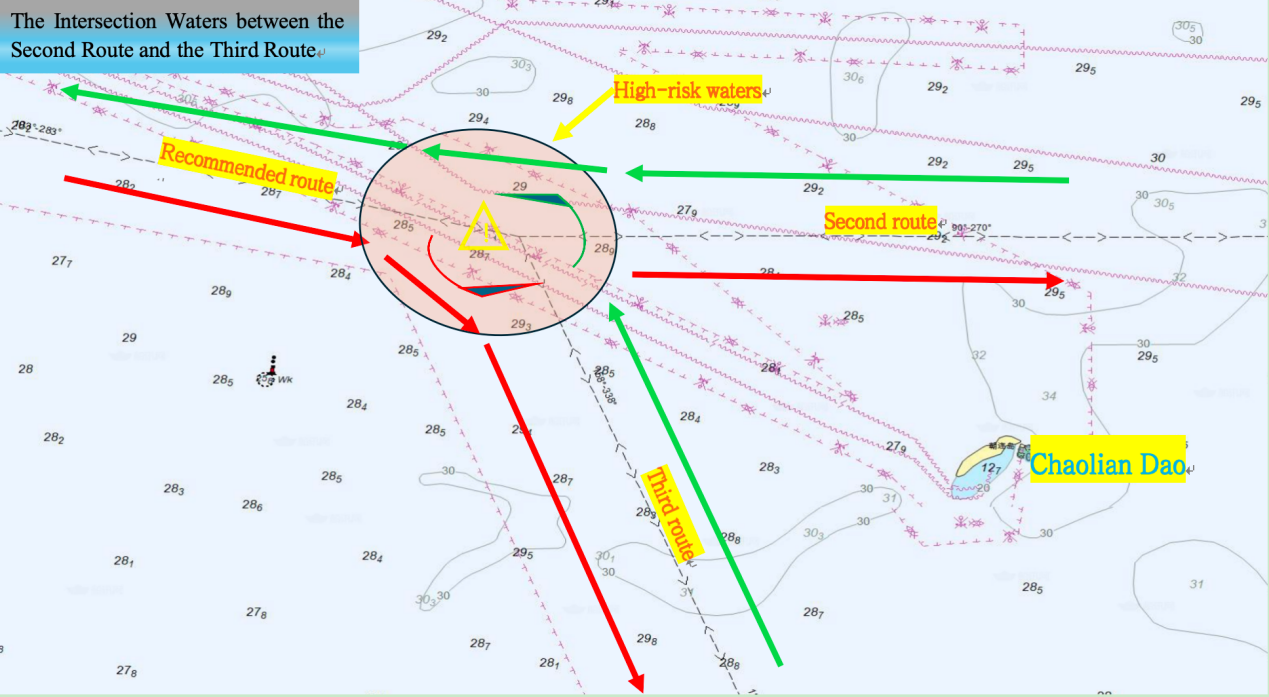
Inbound vessels shall navigate in a counterclockwise circular pattern centered on the intersection point of the two routes. During navigation, vessels shall strengthen communication and coordination with nearby vessels (especially those inbound along the Second Route) and take collision avoidance measures in advance.
Outbound vessels shall enhance communication and coordination with inbound vessels(along the Third Route),take collision avoidance measures in advance and avoid crossing ahead of inbound vessels.
2.2.3 The Chaolian Dao Anchorage No. 1
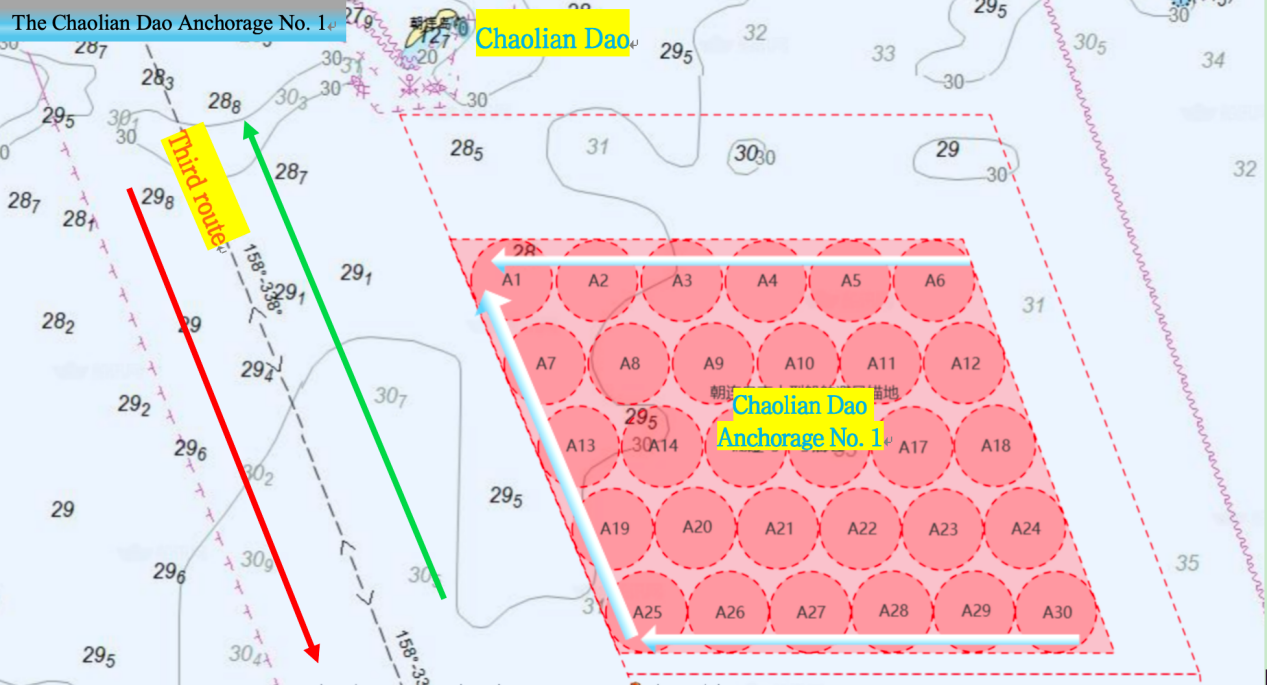 Non-Dangerous Goods Carrier:
Non-Dangerous Goods Carrier:
Anchoring within the designated boundaries of Chaolian Dao Anchorage No.1.
Vessels with short-term anchoring requirements shall prioritize outer anchorage points to facilitate traffic flow.
When Chaolian Dao Anchorage No. 1 is fully occupied, vessels shall proceed to the following alternate areas: South of Chaolian Dao Anchorage No.1、Anchorage No.6 or Anchorage No.7.For vessels navigating through the First Route and the First Reserved Route that require anchorage, it is recommended to use the Anchorage No. 6 or Anchorage No. 7.
Dangerous Goods Carrier: Anchoring in the open waters southeast of Chaolian Dao Anchorage No.1, maintaining a minimum distance of 1 nautical mile from other anchored vessels.
Vessels of Foreign Nationality: Vessels of foreign nationality are required to report to the designated maritime administration when entering the territorial sea of the P.R.China.
Vessels not using anchorages shall avoid crossing anchorage areas.Vessels should avoid anchoring in the western waters outside the designated anchorage areas.
3.Navigation Precautions
3.1 Vessels shall thoroughly assess situations involving fishing boats crossing the recommended routes or operating within the routes, and take early and substantial actions to keep clear of fishing boats and fishing gear.
3.2 Lateral Safe Distance Requirements
3.2.1 The No.1 Traffic Lane of Qingdao TSS:
Overtaking is prohibited in this area.Vessels are advised to maintain a lateral safe distance of at least 0.2 nautical miles, and pay particular attention to the situation that outbound vessels may alter course abruptly during pilot disembarkation in rough seas.
3.2.2 No.2 and No.3 Traffic Lanes of Qingdao TSS:
Vessels are advised to maintain a lateral safe distance of at least 0.3 nautical miles. If overtaking is necessary, a minimum distance of 0.2 nautical miles from other vessels is advised and vessels are required to pay special attention to the lateral distance from vessels in deep-water channel.
3.2.3 Non-TSS waters of Qingdao Port Main Channel:
Vessels are advised to maintain a lateral safe distance of at least 0.5 nautical miles.If overtaking is necessary, a minimum distance of 0.3 nautical miles from other vessels is advised.
Vessels shall increase distances based on the prevailing circumstances and conditions.
3.3 Vessels shall enhance watchkeeping vigilance, monitor meteorological and sea conditions closely, and implement adequate pollution prevention, firefighting, and anti-icing measures.
3.4 In case of berthing schedule adjustment, mechanical malfunctions, or other anomalies, vessels shall report to Qingdao VTS immediately and avoid drifting in high-density traffic areas.
3.5 In case of accidents or distresses, vessels shall initiate self-rescue operations immediately and report to Qingdao Maritime Search and Rescue Center via VHF CH08、Maritime Distress Emergency Call: +86-532-12395 or other effective methods.
3.6 Under all circumstances, these navigational precautions are provided only for reference and do not exempt shipowners, captains, or related parties from their responsibilities for safe navigation.
The opinions expressed herein are the author's and not necessarily those of The Xinde Marine News.
Please Contact Us at:
media@xindemarine.com






 World’s Largest LNG Dual-Fuel Container Ship Deli
World’s Largest LNG Dual-Fuel Container Ship Deli  Navigation Guidelines and Precautions for the Qingd
Navigation Guidelines and Precautions for the Qingd  BYD Accelerates Its Global Expansion at Sea!
BYD Accelerates Its Global Expansion at Sea!  Baltic Exchange launches new Fuel Equivalence Conve
Baltic Exchange launches new Fuel Equivalence Conve  21 Consecutive Years of QUALSHIP 21 Recognition for
21 Consecutive Years of QUALSHIP 21 Recognition for 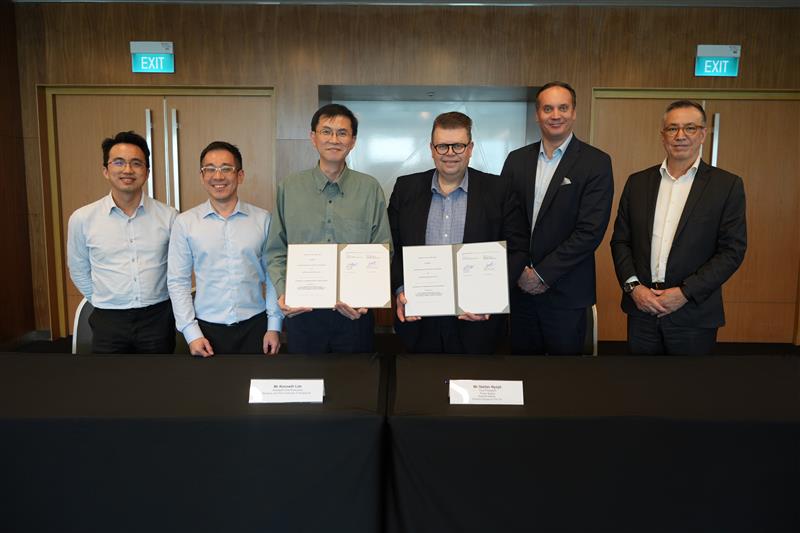 MPA and Wärtsilä Renew Partnership to Drive Marit
MPA and Wärtsilä Renew Partnership to Drive Marit